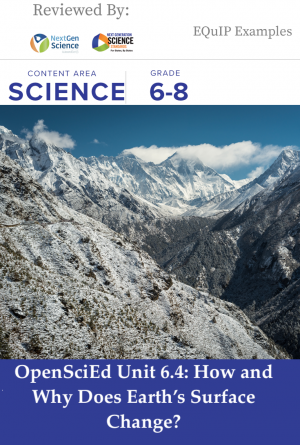
OpenSciEd is a nonprofit organization that brings together educators, philanthropic organizations, curriculum developers, and professional development providers to improve science education through the development and implementation of high-quality, freely available science instructional materials. While this work has begun at the middle school level with Grades 6 through 8, the goal of OpenSciEd is to ensure that all educators, from elementary to high school, have access to a free, coherent, rigorous, research-based set of instructional materials that will support all students in meeting the vision for science literacy described in A Framework for K-12 Science Education and the Next Generation Science Standards.
Score: 8
Awarded the NGSS Design Badge
Science Discipline: Earth and Space Science
Length: Unit
Year Reviewed: 2021
Mountains move! And there are ocean fossils on top of Mt. Everest! In this plate tectonics and rock cycling unit, students come to see that the Earth is much more active and alive than they have thought before. The unit launches with documentation of a 2015 Himalayan earthquake that shifted Mt. Everest suddenly to the southwest direction. Students also discover that Mt. Everest is steadily moving to the northeast every year and getting taller as well. Students wonder what could cause an entire mountain to move--all the time in one direction and backwards during an earthquake.
Students investigate other locations that are known to have earthquakes and they notice landforms, such as mountains and ridges that correspond to earthquake patterns. They read texts, explore earthquake and landform patterns using a data visualization tool, and study GPS data at these locations. Students develop an Earth model and study mantle convection motion to explain how Earth’s surface could move from processes below the surface. From this, students develop models to explain different ways plates collide and spread apart, ultimately explaining how Mt. Everest could move all the time in one direction, and also suddenly, in a backward motion, during an earthquake. The unit ends with students using what they have figured out about uplift and erosion to explain how a fossil was found at Mt. Everest without having to dig for it.
Link to Materials
The following link will direct you to OpenSciEd’s Unit 6.4: OpenSciEd Unit 6.4: How and Why Does Earth’s Surface Change?
The NGSS Design Badge is awarded only to the version of this unit that was reviewed. If any modifications are made to this unit, the revised version cannot be promoted as having earned the badge.
 Reviews & Questions
Reviews & Questions
No comments submitted